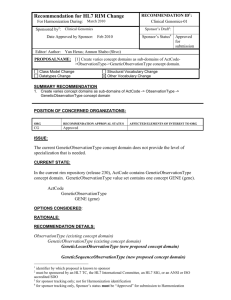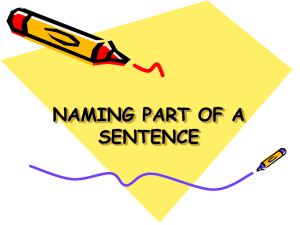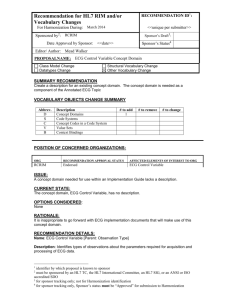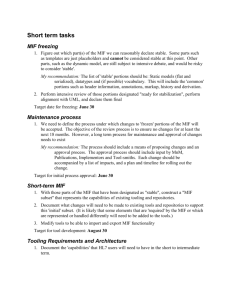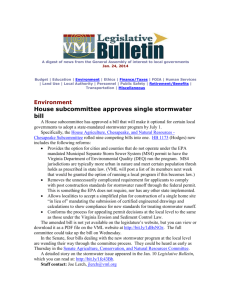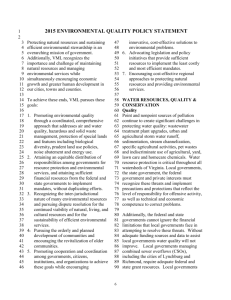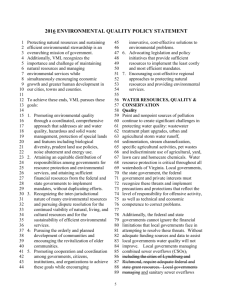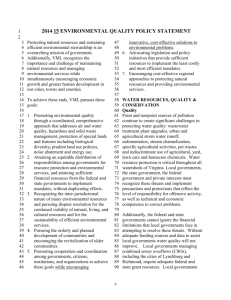Recommendation for HL7 RIM Change (continued)
advertisement
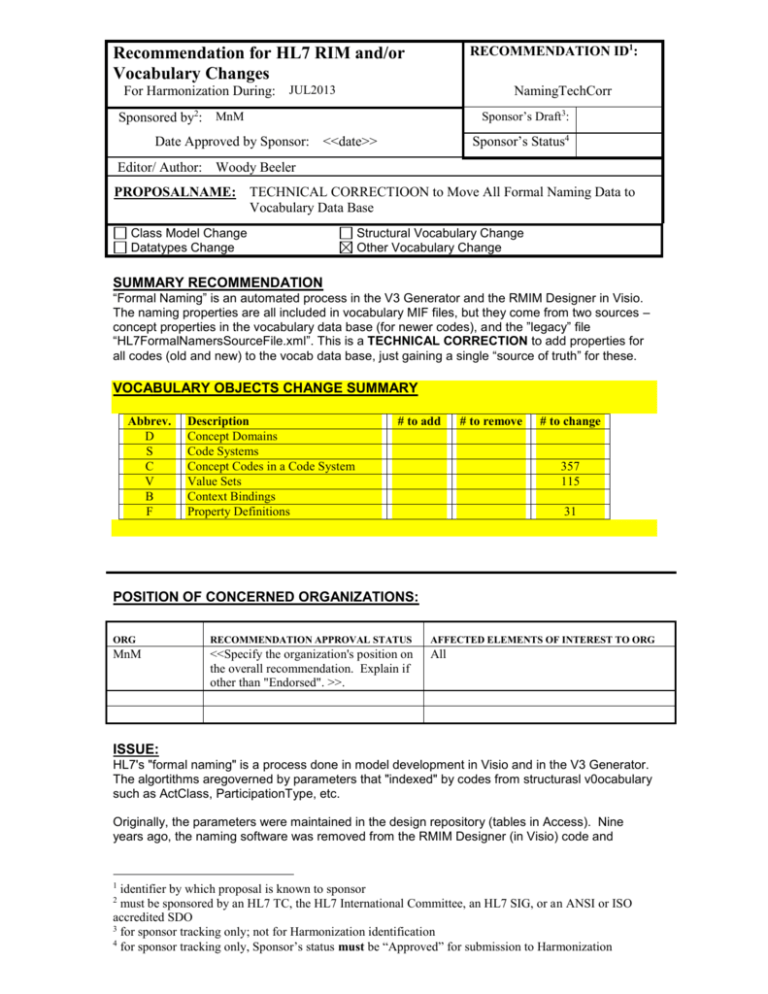
RECOMMENDATION ID1: Recommendation for HL7 RIM and/or Vocabulary Changes For Harmonization During: JUL2013 NamingTechCorr Sponsor’s Draft3: Sponsored by2: MnM Sponsor’s Status4 Date Approved by Sponsor: <<date>> Editor/ Author: Woody Beeler PROPOSALNAME: TECHNICAL CORRECTIOON to Move All Formal Naming Data to Vocabulary Data Base Class Model Change Datatypes Change Structural Vocabulary Change Other Vocabulary Change SUMMARY RECOMMENDATION “Formal Naming” is an automated process in the V3 Generator and the RMIM Designer in Visio. The naming properties are all included in vocabulary MIF files, but they come from two sources – concept properties in the vocabulary data base (for newer codes), and the ”legacy” file “HL7FormalNamersSourceFile.xml”. This is a TECHNICAL CORRECTION to add properties for all codes (old and new) to the vocab data base, just gaining a single “source of truth” for these. VOCABULARY OBJECTS CHANGE SUMMARY Abbrev. D S C V B F Description Concept Domains Code Systems Concept Codes in a Code System Value Sets Context Bindings Property Definitions # to add # to remove # to change 357 115 31 POSITION OF CONCERNED ORGANIZATIONS: ORG RECOMMENDATION APPROVAL STATUS AFFECTED ELEMENTS OF INTEREST TO ORG MnM <<Specify the organization's position on the overall recommendation. Explain if other than "Endorsed". >>. All ISSUE: HL7's "formal naming" is a process done in model development in Visio and in the V3 Generator. The algortithms aregoverned by parameters that "indexed" by codes from structurasl v0ocabulary such as ActClass, ParticipationType, etc. Originally, the parameters were maintained in the design repository (tables in Access). Nine years ago, the naming software was removed from the RMIM Designer (in Visio) code and 1 identifier by which proposal is known to sponsor must be sponsored by an HL7 TC, the HL7 International Committee, an HL7 SIG, or an ANSI or ISO accredited SDO 3 for sponsor tracking only; not for Harmonization identification 4 for sponsor tracking only, Sponsor’s status must be “Approved” for submission to Harmonization 2 Recommendation for HL7 RIM Change (continued) expressed in VB DLLs in order to support development of new RMIM Designer code in the UK. At that time, the parameters were expressed in an XML file (HL7FormalNamersSourceFile.xml). Subsequently, as the V3 Generator was improved, a decision was made to also include these parameters as "properties" of concepts and value sets Vocabulary "core mif" files. This was done by incorporating a software function that picked this data up from the "formal namers" DLL and added the properties to concepts and value sets at the time each new vocabulary release is assembled into MIF from the Vocabulary Access data base. Further, naming parameters for each new concept added to the affected code systems were included directly in the vocabulary, rather than by adding them to the "HL7FormalNamersSourceFile". This resulted in the latter file becoming increasingly outdated. Dual source maintenance is ALWAYS a BAD idea, and has resulted in the formal namers in the RMIM Designer being badly out of date. CURRENT STATE: See above OPTIONS CONSIDERED: There were only two choices: 1. Update the Formal Namers Source file continuously in its idiosyncratic, complex format, and continue to maintain two sources of truth; or 2. Do the RIGHT thing and move all the content to Vocabulary sources, WHERE IT BELONGS. We chose #2 RATIONALE: Remove dual maintenance and advance o a single “source of truth” for formal naming. RECOMMENDATION DETAILS: Accordingly, the RMIM Designer tool-smiths undertook to adopt a "single source of truth" for these in the vocabulary, since this is the up-to-date version and is the one used in the V3 Generator. An XSLT transform has been created to "generate" a complete "HL7FormalNamersSourceFile-generated.xml" that will be used as the source datafor formal naming in Visio. This derived file will be created for each new vocabulary release, and released through the V3 publishing tools, The set of changes in this recommendation migrate all of the older formal naming parameters from the source file to the Vocabulary data base, from where they will be automatically included in the vocabulary releases. Since these changes DO NOT alter the content of the Vocabulary core mif they were adopted as Technical Corrections in April 2013l, subject to confirmation in the July 2013 Harmonization A single VML source file “990099_FinalMigrationOfFormalNamingToVocab_Woody.xml” is provided as an attachment to this proposal. It provides the VML source and Access Queries to perform four step updates: 1. Apply the VML that updates the concept properties for 357 “old” codes. Since there may be more than one property per code, it adds a total of 1042 new property values. 2. USE a CSV table (in the VML comments) as the basis for DELETING VCS_property_definition table rows to allow them to be re-added with descriptions 3. Insert a second CSV table (in the VML comments) into the VCS_property_definition table in the Access DB to read the elements with descriptions Recommendation for HL7 RIM Change (continued) 4. Insert a third CSV table (in the VML comments) into the VCS_object_property table in the Access DB to add properties to Value Sets DISCUSSION: This has been executed and fully tested. I cannot conceive of a reaons for telling us to reverse this correction. ACTION ITEMS: It has been done RESOLUTION:
